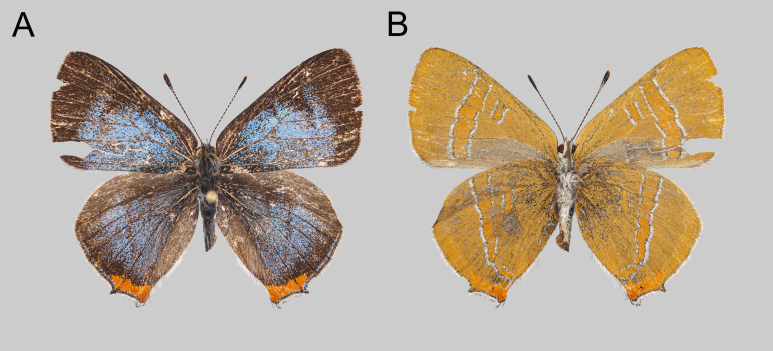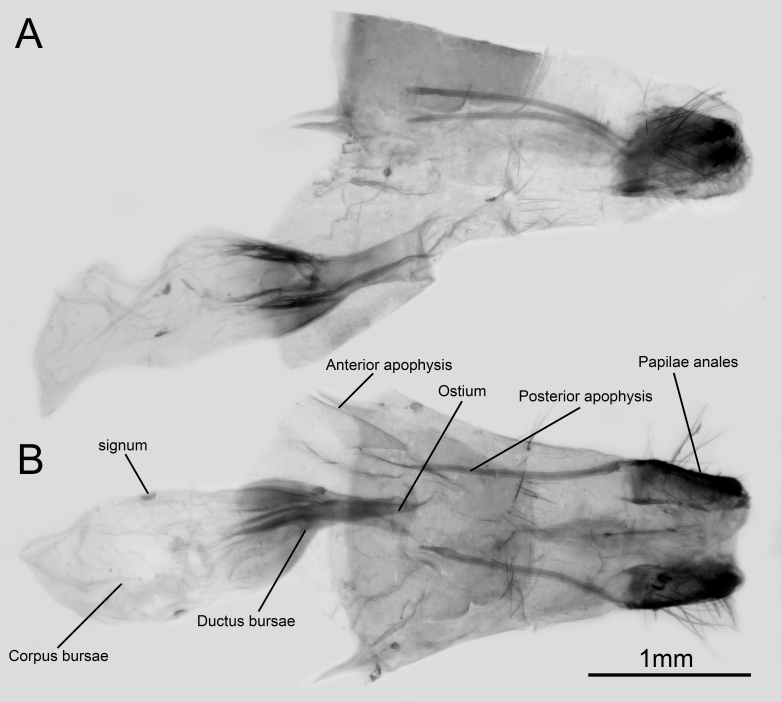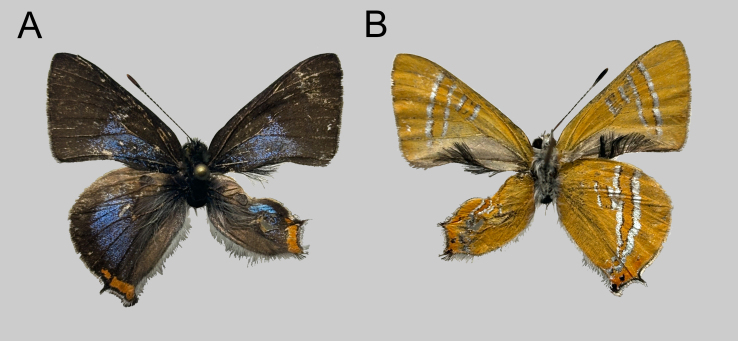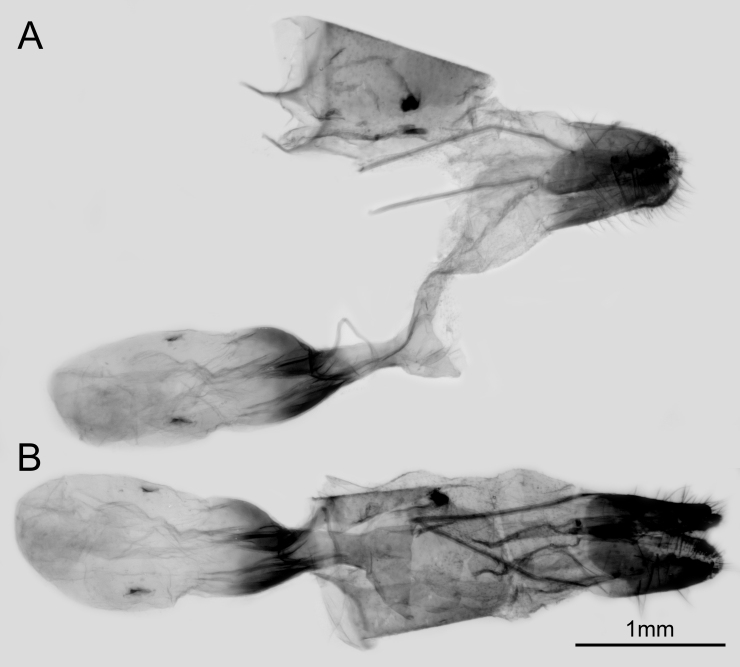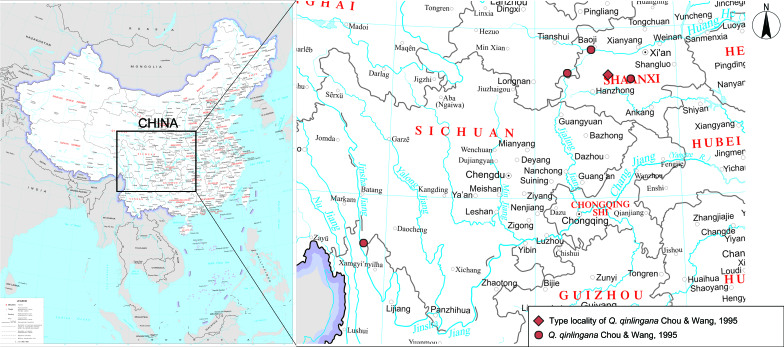Abstract
Background
The family Lycaenidae is a widely distributed and species-rich group with approximately 5300 described species. The rare genus Qinorapala Chou & Wang, with Q.qinlingana Chou & Wang as its type species was established as monotypic. In the original description, Q.qinlingana was described from a male holotype; the female remained unknown. To date, the genus is only recorded from the Qinling Mountains (Shaanxi and Gansu Provinces). In this study, two female specimens, from Shaanxi Province and western Sichuan Province (bordering Yunnan Province) are described and illustrated for the first time.
New information
Female specimens of Q.qinlingana from Shaanxi and Sichuan are described for the first time. The species' distribution is updated and a distribution map is provided.
Keywords: taxonomy, Sichuan, Oriental Region
Introduction
The family Lycaenidae (common name: gossamer-winged butterflies) is a widely distributed and species-rich group with about 5300 described species (Pierce et al. 2002). As the second largest family of Papilionoidea, this group includes many model animals and also several pests, which jointly play important roles in diverse ecosystems (Sharma and Sharma 2021). Most adults of the group are small and brightly coloured with metallic iridescence on the uppersides (Shou et al. 2006).
The monotypic genus Qinorapala Chou & Wang includes only the rare type species Q.qinlingana Chou & Wang. In the original description, Q.qinlingana was described from a male holotype; females were unknown. To date, the genus is only recorded from the Qinling Mountains (Shaanxi and Gansu Provinces).
In this study, two female specimens from Shaanxi Province and western Sichuan Province (bordering Yunnan Province) are described and illustrated for the first time. Kimura 2-parameter (K2P) distances between mitochondrial COI barcode region sequences were calculated. A distribution map of the species is provided.
Materials and methods
Morphological comparison
The specimens from Sichuan Province were photographed using an interchangeable lens digital camera Sony A7M2 digital SLR camera with a Laowa 100 mm macro lens. Final plates were prepared in Adobe Photoshop CC (adobe.com). To study the female genitalia, the abdomens were taken from the specimens and placed into a 1.5 ml microcentrifuge tube, then soaked in 10% potassium hydroxide solution at room temperature for about 24 hours. After dissection, the genitalia were then transferred to 80% glycerol for 12 h to render them transparent.
Molecular phylogenetic analysis
DNA extraction, PCR amplification and sequencing follows Ge et al. (2023). The forward primer LepF (5'-ATTCAACCAATCATAAAGATATTGG-3') and reverse primer LepR (5'-TAAACTTCTGGATGTCCAAAAAATCA-3') employed in Lukhtanov et al. (2009) were used in this study. The phylogeny was reconstructed using the Neighbour-Joining method by Mega11, with 500 replications of bootstrap to test the phylogeny (Tamura et al. 2021). Four specimens of Q.qinlingana were selected as ingroups, with three of them newly sequenced in this study (two males from Shaanxi Province and a female from Sichuan), the remaining one being extracted from Kawahara et al. (2023). Sequences of outgroup taxa were selected amongst the mostly closely-related species with COI data on GenBank according to the genus-level phylogeny of Kawahara et al. (2023). All new sequences were deposited in GenBank (BioProject PRJNA967499: accession numbers OR825799-OR825801).
Data resources
Three specimens of Q.qinlingana employed in phylogenetic analysis were from Si-Xun Ge's collection and Shi-Yu Tong's collection (a male from Shaanxi Province belongs to Shi-Yu Tong's collection, another male from Shaanxi and the female from Sichuan belongs to Si-Xun Ge's collection). New sequences were deposited in GenBank (BioProject PRJNA967499: accession numbers OR825799-OR825801).
Taxon treatments
Qinorapala
Chou & Wang, 1995
25EAF320-4F0B-5E29-B2C9-F0A186BBB551
Qinorapala qinlingana Chou & Wang, 1995Chou and Wang 1995
Diagnosis
Forewing with veins M1 and R4+5 stalked, male with a hair tuft on underside along dorsum. Hind-wing with a short tail at vein CuA2 and a scent brand in space Sc+R1, tornal lobe poorly-developed. Male genitalia with valve not conjoined ventrally.
Distribution
West China (Shaanxi, Gansu, Sichuan).
Qinorapala qinlingana
Chou & Wang, 1995
E76DA4C0-FC6F-5436-8E6B-CF12026BA331
Materials
Type status: Other material. Occurrence: sex: female; preparations: photograph; occurrenceID: 4047D57B-B010-52AB-811E-00D9FD0C0D0F; Taxon: scientificName: Qinorapalaqinlingana; order: Lepidoptera; family: Lycaenidae; genus: Qinorapala; taxonRank: species; Location: higherGeography: West China; country: China; countryCode: CN; stateProvince: Shaanxi; verbatimLocality: Jialing River Source Scenic Spot; verbatimElevation: 2800 m; Identification: identifiedBy: Jian Luo; Event: eventTime: 2011; year: 2011
Type status: Other material. Occurrence: sex: female; preparations: photograph; DNA extract; associatedSequences: GenBank: OR825799.1; occurrenceID: 9B833B39-427D-598D-9A13-96C22C88272C; Taxon: scientificName: Qinorapalaqinlingana; order: Lepidoptera; family: Lycaenidae; genus: Qinorapala; specificEpithet: qinlingana; taxonRank: species; Location: country: China; countryCode: CN; stateProvince: Sichuan; county: Derong; locality: 8–10 km south of Bendu township (along the National Highway 215); verbatimElevation: 2500-3000 m; Identification: identifiedBy: Sixun Ge; Event: year: 2023; month: 4
Type status: Other material. Occurrence: individualCount: 2; sex: 2 males; lifeStage: adult; preparations: photograph DNA extract; associatedSequences: GenBank: OR825800.1; OR825801.1; occurrenceID: 08E7368E-2E02-5B86-82E8-B3CD7A961634; Taxon: scientificName: Qinorapalaqinlingana; family: Lycaenidae; genus: Qinorapala; Location: country: China; countryCode: CN; stateProvince: Shaanxi; county: Ningshan; locality: Huangguan Township; verbatimElevation: 1300 m; Identification: identifiedBy: Sixun Ge; Event: samplingEffort: Sweep net; eventDate: 1 May 2020; year: 2020; month: 5; day: 1; Record Level: basisOfRecord: PreservedSpecimen
Description
Female from Sichuan Province (Fig. 1) : Length of forewing 16.5 mm. Upperside (Fig. 1): Fore- and hind-wings with distinct sky-blue iridescence, forewing with veins brownish, partly suffused with blue scales; post-discal band brownish, weakly developed; median band faint and narrow, extended to space Cu1. Dark brownish border broadening at apex rather developed, from costal to tornal angle. Hind-wing ground colour as in forewing with costal margin and outer margin brownish; outer margin with distinct sky-blue marginal band. Tails extremely short; orange tornal spot bright-coloured, distinctly developed in spaces Cu2, Cu1 and M1. Underside (Fig. 1): Both wings pale orange coloured, post-discal band and median band pale tangerine with narrower whitish margins. Tornus of hind-wing light orange-coloured, similar to upperside with a tiny black spot in space 2.
Figure 1.
Female of Qinorapalaqinlingana Chou & Wang, 1995 collected 8-10 km south of Bendu township (along National Highway 215), Derong County, Sichuan, China: upperside (A) and underside (B).
Female genitalia (Fig. 2) with papillae anales highly sclerotised; posterior apophyses long and slender; anterior apophyses acute; ostium nearly round. Ductus bursae moderately sclerotised; corpus bursae dentoliva-shaped.
Figure 2.
Female genitalia of Q.qinlingana from Sichuan: lateral view (A) and dorsal view (B).
Male from Shaanxi Province. Upperside (Fig. 3): Both wings dark brownish with greyish-blue iridescence. Forewing with metallic patch basally along dorsum, situated in the basal 3/5 of the space Cu2, 2A and basal 1/3 of Cu1. Hind-wing with costal margin and outer margin dark brownish. Tails short; orange tornal spot bright orange coloured. Underside (Fig. 3): Both wings pale orange coloured, post-discal band and median band pale orange with rather broad silvery-white margins. Forewing with black androconia distinctly developed on the posterior margin. Tornus of hind-wing with slight orange hue, with distinct black spots in spaces 1b and 2.
Figure 3.
Male of Q.qinlingana Chou & Wang, 1995 collected in Huangguan Township, Ningshan County, Shaanxi, China: upperside (A) and underside (B).
Female from Shaanxi Province (Fig. 4). The head and antennae of the specimen are missing. Upperside (Fig. 4): Both wings with greyish-blue iridescence, forewing with veins brownish, partly suffused with blue scales; post-discal band brownish, distinctly developed; median band distinct and broad, extended to space 2. Dark brownish border broadening at apex rather developed, from costal to tornal angle. Hind-wing with costal margin and outer margin brownish; outer margin with greyish-blue marginal band. Tails short; orange tornal spot dark-coloured, present in spaces 1b, 2 and 3. Underside (Fig. 4): Both wings pale yellowish coloured, post-discal band and median band pale orange with rather broad silvery-white margins. Tails black; tornus of hind-wing with slight orange hue, with distinct black spots in spaces 1b and 2.
Figure 4.
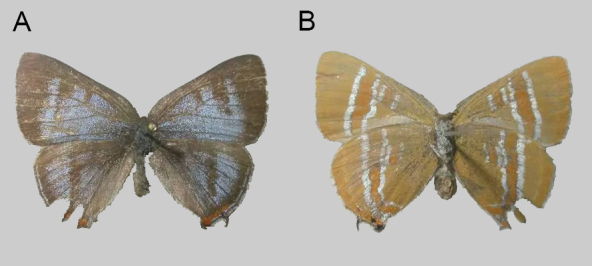
Female of Q.qinlingana Chou & Wang, 1995 collected in Jialing River Source Scenic Spot, Baoji City, Shaanxi, China: upperside (A) and underside (B).
Female genitalia (Fig. 5) with papillae anales highly sclerotised; posterior apophyses long and slender; lamella antevaginalis and lamella postvaginalis not distinctly sclerotised; anterior apophyses acute; ostium broad and round. Ductus bursae highly sclerotised; corpus bursae dentoliva-shaped.
Figure 5.
Female genitalia of Q.qinlingana from Shaanxi: lateral view (A) and dorsal view (B).
Distribution
West China (Shaanxi, Gansu, Sichuan)
Taxon discussion
The female specimen described in this study shows apomorphic morphological characters that prove conspecificity with the male holotype, as the forewing with veins M1 and R4+5 stalked; hind-wing with an extremely short tail and whitish or silvery-white margins of post-discal band and median band. The Neighbour-Joining phylogenetic analysis, based on partial sequences of COI (Fig. 6), also confirms that the female specimen and the male specimens belong to the same species, because the four specimens of Q.qinlingana were clearly defined as monophyletic with high bootstrap support and the branch length of all Q.qinlingana samples is 0, indicating that there is no genetic difference between samples.
Figure 6.
The Neighbour-Joining phylogenetic tree of the Q.qinlingana. Values at nodes indicate the bootstrap values.
Notes
Before this study, there were fewer than a dozen known specimens of Q.qinlingana and females of the species were not described. Here, we first described the female of Q.qinlingana and provided its distribution information (Fig. 7). There are minor morphological differences in specimens from Sichuan and Shaanxi. The colour of wings and the shape of discal and median bands: in the specimen from Sichuan with both bands narrower, margins on the underside narrower and whitish, while in the specimen from Shaanxi, broad and silvery white. The tails: in the Sichuan specimen extremely short, but in the Shaanxi specimen, comparatively long. The tornal spot: the Sichuan specimen with tornal spot large and bright-coloured, while in the Shaanxi specimen, comparatively small and dark. However, there is no visible difference in female genitalia between the two specimens and no difference on partial sequences of COI between specimens from Shaanxi and Sichuan, so we treat them as the same taxon.
Figure 7.
Distribution map of Q.qinlingana Chou & Wang, 1995. Map of China from http://bzdt.ch.mnr.gov.cn/index.html.
Supplementary Material
Acknowledgements
We thank Prof. Shi-Xiang Zong, Mr. Yi-Zhou Liu and Mr. Jia-Ru Ren (Beijing Forestry University) for their support for this study. We thank Mr. Adam M. Cotton (Chiang Mai, Thailand) for improving the earlier drafts of this article. We also thank Mr. Jian Luo, Mr. Chun-Hao Wang (Chaoyang District, Beijing) and Mr. Shi-Yu Tong (Xi’an, Shaanxi) for their supplementation of experimental materials. The research was supported jointly by the National Key R & D Program of China 2022YFD1401000; National Natural Science Foundation of China (NSFC, No. 31872263, 31572300) and the Academician (Expert) Working Station (202305AF150037) of Yunnan Provincial Department of Science and Technology.
Funding Statement
The research was supported jointly by the National Key R & D Program of China (2022YFD1401000); National Natural Science Foundation of China (NSFC, No. 31872263, 31572300) and the Academician (Expert) Working Station (202305AF150037) of Yunnan Provincial Department of Science and Technology.
Contributor Information
Li-Li Ren, Email: lily_ren@bjfu.edu.cn.
Shao-Ji Hu, Email: shaojihu@hotmail.com.
References
- Chou I., Wang M. A new genus and a new species of Lycaenidae (Lepidoptera: Rhopalocera) from China. Entomotaxonomia. 1995;17(2):132–134. [Google Scholar]
- Ge S. X., Jiang Z. H., Wang J. Q., Song K., Zhang C., Hu S. J. A revision of the Pierisnapi-complex (Lepidoptera: Pieridae) and similar species with distribution in China. Arthropod Systematics & Phylogeny. 2023;81:257–287. doi: 10.3897/asp.81.e85191. [DOI] [Google Scholar]
- Kawahara A. Y., Storer C., Carvalho A. P.S., et al. A global phylogeny of butterflies reveals their evolutionary history, ancestral hosts and biogeographic origins. Nat Ecol Evol. 2023;7:903–913. doi: 10.1038/s41559-023-02041-9. [DOI] [PMC free article] [PubMed] [Google Scholar]
- Lukhtanov V. A., Sourakov A., Zakharov E. V., Hebert P. D. DNA barcoding Central Asian butterflies: increasing geographical dimension does not significantly reduce the success of species identification. Molecular Ecology Resources. 2009;9(5):1302–1310. doi: 10.1111/j.1755-0998.2009.02577.x. [DOI] [PubMed] [Google Scholar]
- Pierce N. E., Braby M. F., Heath A., Lohman D. J., et al. The ecology and evolution of ant association in the Lycaenidae (Lepidoptera) Annual Review of Entomology. 2002;47:733–771. doi: 10.1146/annurev.ento.47.091201.145257. [DOI] [PubMed] [Google Scholar]
- Sharma N., Sharma S. Assemblages and seasonal patterns in butterflies across different ecosystems in a sub-tropical zone of Jammu Shiwaliks, Jammu and Kashmir, India. Tropical Ecology. 2021;62(5) [Google Scholar]
- Shou JX., Chou I., Li YF. Systematic butterfly names of the world. Shaanxi Science and Technology Press; Xi'an: 2006. 36-37 [Google Scholar]
- Tamura K., Stecher G., Kumar S. MEGA11: Molecular Evolutionary Genetics Analysis Version 11. Mol Biol Evol. 2021;38(7):3022–3027. doi: 10.1093/molbev/msab120.. [DOI] [PMC free article] [PubMed] [Google Scholar]
Associated Data
This section collects any data citations, data availability statements, or supplementary materials included in this article.



